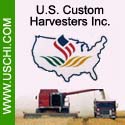 |
 |

|
|
|
Kansas Ag News Headlines |
 |
Kansas Wheat Quality Degrading, Challenged by Lack of Moisture
Kansas Ag Connection - 03/24/2017
Dry winter weather that helped fuel wildfires in Kansas and other Plains states also left many wheat fields in need of moisture even as above-average temperatures pushed wheat plants to green up earlier than usual.
The dry conditions through much of the state left some wheat fields in tough shape, said Kansas State University agronomy assistant professor Romulo Lollato.
Total precipitation from Sept. 1, 2016, to Feb. 28, 2017, varied widely with some areas receiving far more than normal precipitation while the entire southwest quarter of Kansas received below-normal precipitation, according to the Kansas Weather Data
Library.
"As a consequence of the precipitation shortage last fall in southwest Kansas, many fields there have erratic stands or are just now germinating or emerging," said Lollato, a wheat specialist with K-State Research and Extension. That leaves growers facing
several agronomic and economic considerations as they decide whether to maintain the crop or plant the field to a different spring-planted crop.
In fields where the wheat seed sowing depth was relatively deep (2 inches), the first leaf may have started below ground, he said. Some of those plants may never push through the soil surface, so those fields may have scattered wheat stands. In other fields that
were dry last fall and now have moisture, shoots may push through and producers could end up with a decent stand. In these cases, sowing depth, seed treatment, seed vigor, and occurrence of pests and diseases will affect the final stand.
Previous research indicates that fields that are just now emerging, months after they normally would, have about half the yield potential of a crop that emerged and tillered in the fall. Spring weather, of course, will still be a factor, Lollato said. "If the weather turns
cool and moist during the spring, these fields might still yield okay, but if we have a more normal warm and dry year, the yield reduction could be even worse than half."
Spring-emerged wheat will likely have thinner stands across the field which could give weeds a greater chance to thrive and pressure the wheat. Some spring-emerged wheat may also have problems vernalizing. Some varieties need six to eight weeks of soil
temperatures below 50 degrees.
If a grower's wheat doesn't emerge until spring but the stand is decent, the crop will still have reduced yield potential compared to a normal fall-emerged crop, as spring tillers are less productive than fall tillers, Lollato said. Producers in this situation should take a
stand count to determine the final number of plants emerged per row foot and compare it with a target stand. Information about taking a stand count and how to compare it with a target stand is available online in the March 3 K-State Agronomy eUpdate
newsletter or by contacting a local K-State Research and Extension office.
"If the stand is decent compared to the target stand, consider whether having a reduced yield potential is affordable," Lollato said. "If the stand is not decent or producers cannot afford the reduced yield potential, terminating the crop and going into a summer
crop may be an option, herbicide restrictions allowing."
Above-normal winter temperatures resulted in an early greening of wheat fields, with some already past the jointing stage of development in south-central areas.
"The early spring green-up will require producers to make certain management practices, such as nitrogen fertilization, earlier than normal," the agronomist said. "Winter wheat turns from vegetative to reproductive development after its vernalization requirements
are met -- normally in early spring, so the number of spikelets per head is determined at greenup. Having nitrogen in the root zone by then is critical to ensure good head formation and to maximize the number of spikelets per head."
Insect management is another important consideration in warmer-than-usual conditions.
Another major consequence of the early start to this growing season is the heightened risk of freeze injury to the developing crop, Lollato said. He noted the average last date for freezing temperatures in Kansas ranges from early April in southeast Kansas to
early May in northwest Kansas.
Where the crop is developing early, it is more likely to be in more-sensitive phases of development if and when a freeze occurs this spring, he said. A recent cold snap, during which minimum air temperatures reached as low as 9 degrees Fahrenheit from March
8-14, is a good example of that. While most Kansas wheat should have dodged the detrimental effects of that freeze event, especially fields where the growing point was still below ground, it highlights how the crop may be vulnerable to a freeze in the near
future. As of March 22, many fields around the state are reaching the jointing stage of growth, and a similar cold snap could be much more detrimental.
If the crop escapes freeze injury, either by a mismatch between freeze occurrence and highly sensitive growth stages or due to the absence of a freeze, an early spring green-up might signify an early grain fill period.
"During the 2015-2016 growing season, the Kansas crop avoided three major freeze events due to a mismatch between freeze occurrence and sensitive stages of development, and yields were generally very good since the crop experienced good grain-filling
conditions," Lollato said. "It will all depend on the weather moving forward."
He said many fields are showing yellowing of older leaves, typically from a combination of drought and nitrogen deficiency stresses. "In many cases, producers were timely applying the nitrogen to the wheat crop, but the lack of moisture did not distribute the
nitrogen to the root zone, where it needs to be in order for uptake. If this week's precipitation forecast materializes, it will be beneficial to the crop to reduce some of the drought stress and ensure nitrogen is in the root zone for plant uptake."
Kansas wheat rated 24 percent poor to very poor, 38 percent fair, 36 percent good and 2 percent excellent as of the week ended March 19, 2017, according to the USDA-National Agricultural Statistics Service. Ten percent of the wheat was jointed, behind
last year but near the five-year average of eight. The condition of the crop has been slipping in recent weeks.
USDA-NASS also rated topsoil moisture across Kansas as 29 percent very short, 45 percent short, 26 adequate, and 0 surplus, as of March 20. Subsoil moisture rated 21 percent very short, 40 percent short, 39 adequate and 0 surplus.
|
 |


|
 |
|
Copyright © 2024 - Farms.com. All Rights Reserved. |
 |
|